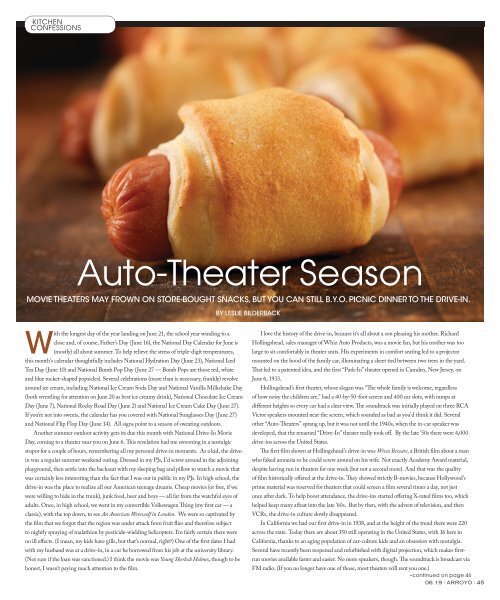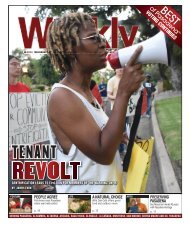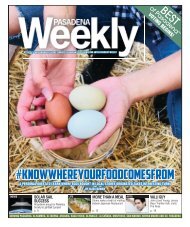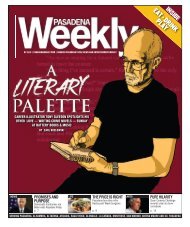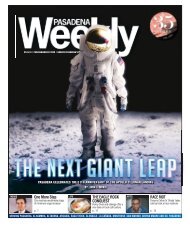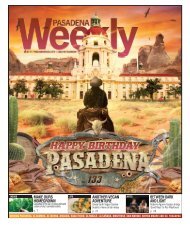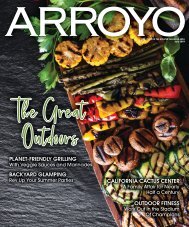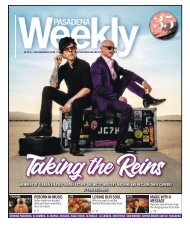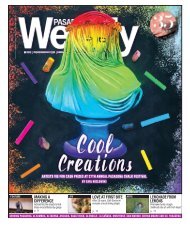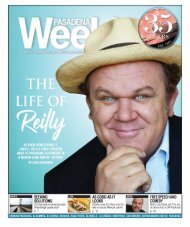Create successful ePaper yourself
Turn your PDF publications into a flip-book with our unique Google optimized e-Paper software.
KITCHEN<br />
CONFESSIONS<br />
Auto-Theater Season<br />
MOVIE THEATERS MAY FROWN ON STORE-BOUGHT SNACKS, BUT YOU CAN STILL B.Y.O. PICNIC DINNER TO THE DRIVE-IN.<br />
BY LESLIE BILDERBACK<br />
With the longest day of the year landing on <strong>June</strong> 21, the school year winding to a<br />
close and, of course, Father’s Day (<strong>June</strong> 16), the National Day Calendar for <strong>June</strong> is<br />
(mostly) all about summer. To help relieve the stress of triple-digit temperatures,<br />
this month’s calendar thoughtfully includes National Hydration Day (<strong>June</strong> 23), National Iced<br />
Tea Day (<strong>June</strong> 10) and National Bomb Pop Day (<strong>June</strong> 27 — Bomb Pops are those red, white<br />
and blue rocket-shaped popsicles). Several celebrations (more than is necessary, frankly) revolve<br />
around ice cream, including National Ice Cream Soda Day and National Vanilla Milkshake Day<br />
(both wrestling for attention on <strong>June</strong> 20 as best ice creamy drink), National Chocolate Ice Cream<br />
Day (<strong>June</strong> 7), National Rocky Road Day (<strong>June</strong> 2) and National Ice Cream Cake Day (<strong>June</strong> 27).<br />
If you’re not into sweets, the calendar has you covered with National Sunglasses Day (<strong>June</strong> 27)<br />
and National Flip Flop Day (<strong>June</strong> 14). All signs point to a season of sweating outdoors.<br />
Another summer outdoor activity gets its due this month with National Drive-In Movie<br />
Day, coming to a theater near you on <strong>June</strong> 6. This revelation had me swooning in a nostalgic<br />
stupor for a couple of hours, remembering all my personal drive-in moments. As a kid, the drivein<br />
was a regular summer weekend outing. Dressed in my PJs, I’d screw around in the adjoining<br />
playground, then settle into the backseat with my sleeping bag and pillow to watch a movie that<br />
was certainly less interesting than the fact that I was out in public in my PJs. In high school, the<br />
drive-in was the place to realize all our American teenage dreams. Cheap movies (or free, if we<br />
were willing to hide in the trunk), junk food, beer and boys — all far from the watchful eyes of<br />
adults. Once, in high school, we went in my convertible Volkswagen Thing (my first car — a<br />
classic), with the top down, to see An American Werewolf in London. We were so captivated by<br />
the film that we forgot that the region was under attack from fruit flies and therefore subject<br />
to nightly spraying of malathion by pesticide-wielding helicopters. I’m fairly certain there were<br />
no ill effects. (I mean, my kids have gills, but that’s normal, right?) One of the first dates I had<br />
with my husband was at a drive-in, in a car he borrowed from his job at the university library.<br />
(Not sure if the loan was sanctioned.) I think the movie was Young Sherlock Holmes, though to be<br />
honest, I wasn’t paying much attention to the film.<br />
I love the history of the drive-in, because it’s all about a son pleasing his mother. Richard<br />
Hollingshead, sales manager of Whiz Auto Products, was a movie fan, but his mother was too<br />
large to sit comfortably in theater seats. His experiments in comfort seating led to a projector<br />
mounted on the hood of the family car, illuminating a sheet tied between two trees in the yard.<br />
That led to a patented idea, and the first “Park-In” theater opened in Camden, New Jersey, on<br />
<strong>June</strong> 6, 1933.<br />
Hollingshead’s first theater, whose slogan was “The whole family is welcome, regardless<br />
of how noisy the children are,” had a 40-by-50-foot screen and 400 car slots, with ramps at<br />
different heights so every car had a clear view. The soundtrack was initially played on three RCA<br />
Victor speakers mounted near the screen, which sounded as bad as you’d think it did. Several<br />
other “Auto-Theaters” sprang up, but it was not until the 1940s, when the in-car speaker was<br />
developed, that the renamed “Drive-In” theater really took off. By the late ’50s there were 4,000<br />
drive-ins across the United States.<br />
The first film shown at Hollingshead’s drive-in was Wives Beware, a British film about a man<br />
who faked amnesia so he could screw around on his wife. Not exactly Academy Award material,<br />
despite having run in theaters for one week (but not a second more). And that was the quality<br />
of film historically offered at the drive-in. They showed strictly B-movies, because Hollywood’s<br />
prime material was reserved for theaters that could screen a film several times a day, not just<br />
once after dark. To help boost attendance, the drive-ins started offering X-rated films too, which<br />
helped keep many afloat into the late ’60s. But by then, with the advent of television, and then<br />
VCRs, the drive-in culture slowly disappeared.<br />
In California we had our first drive-in in 1938, and at the height of the trend there were 220<br />
across the state. Today there are about 350 still operating in the United States, with 16 here in<br />
California, thanks to an aging population of car-culture kids and an obsession with nostalgia.<br />
Several have recently been reopened and refurbished with digital projection, which makes firstrun<br />
movies available faster and easier. No more speakers, though. The soundtrack is broadcast via<br />
FM radio. (If you no longer have one of those, most theaters will rent you one.)<br />
–continued on page 46<br />
06.19 | ARROYO | 45


